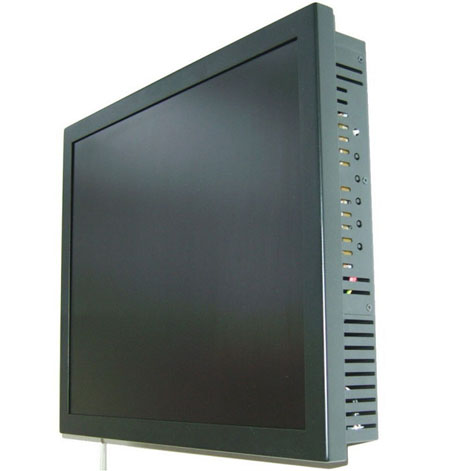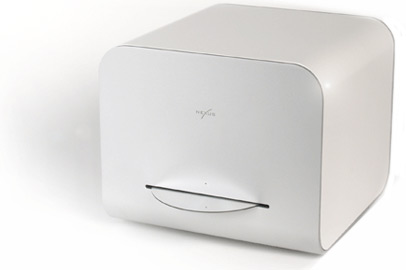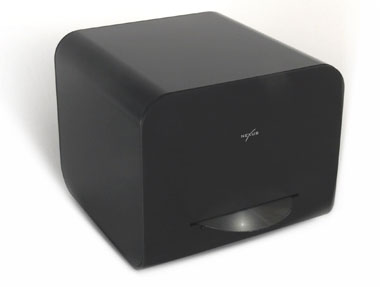
Following up on some earlier posts about showing new media work in the gallery and digital non-sites, here's some recent writing on gallery friendly hardware set-ups, for art that absolutely has to be shown on a computer screen (as opposed to DVDs). Olia Lialina discusses the "Torch" brand of screen-with-built-in-computer here. I still have some questions about that device (photo above), asked in the spirit of being open source:
--The website says there is no hard drive for the slim computer--how is the data stored for a piece?
--Why do they have all the USB ports and such? It looks like an awful lot of computer just to run GIFs (or whatever programs are providing content for the screen). When I saw Lialina's work at Bryce Wolkowitz gallery I assumed it was some kind of flash memory built into the screen.
--Doesn't it have an operating system that has to boot up each time it's turned on, and then a program on the operating system to run the GIFs, all accessed by hooking a mouse and keyboard to the ports on the computer? Can it run without Windows XP, which Torch describes as "optional"? (Lialina says via email that hers was Linux and there was no boot screen. Linux--aiee!) [update--some answers to these qs below]
Many of these same issues are raised and answered with respect to a Mac Mini or PC setup in this post Showing Video via Computers by artist Paul Slocum, who is also running a gallery. It's very thorough and helpful even though it makes me want to stick with just popping a DVD in a hundred dollar player and dealing as an artist with the compression artifacts. It's a lot to ask a harried gallerist to memorize this how-to and/or constantly go yourself to the space to see what's wrong with the computer. Especially for work that anyone in the world can see displayed perfectly well on the Internet, at home. But that's just me ducking responsibility--artists are obviously coping with these issues.
Update: Some late thoughts. That Torch Computer screen is elegant in person, very generic, and I like that they deliberately made it without a logo anywhere visible. I'd like to own a few (once I get my mundane practical questions answered), and I think it would be a good investment for galleries that show new media art on a regular basis to own a few. I would even like to see it be something that collectors buy. My questions are aimed at making some kind of "display lingua franca" that everyone is accustomed to using for certain types of work. As opposed to reinventing the wheel with every show or making the show be "about" what major corporation's hardware you are plugging. I believe that is what Lialina is proposing in her article.
Update 2: Paul learned the following from Torch: "19 inch LCD screen, 1280 X 1024 resolution, with built-in mini-ITX computer...with built-in 1GHz CPU, 256MB RAM. There are two versions of this. The Linux version comes with a flash memory of 1GB and operating software that reads a web page from a USB pendrive, also supplied, that is displayed on the screen without any visible indication that it is a browser. That is, there are no visible frames, scroll bars, menu bars, tool bars, etc. This version is priced at 595.00 pounds ($1169). The other version is supplied with a 40GB hard disk drive and Windows XP Home. This is priced at 665.00 pounds ($1307). All prices exclude shipment charges, duties and and taxes." (As Paul notes, shipping and taxes for the cheaper of these UK products could be $300-600 to the US. They are custom-made and take 4-8 weeks to prepare.)
Check out the PhotoVu frames. I've had one for almost two years and it is the greatest. You could matte and/or frame however you want.
Thanks. I think these are only for still photos, right?
What's needed is a standard "artist display computer" that's flexible enough to handle different types of files and projects. Not so much to frame it but just to present it reasonably minimally in the gallery, without the Samsung logo or the inevitable cord leading to a seen or unseen hard drive.
I think the PhotoVu will do animated GIF's. Video files are supposed to be supported in an upcoming software release. Check with the manufacturer. They are very helpful.
I'm just worried the price is going to be a punch in the face. I've emailed them...
And also worth mentioning is that Toshiba has a line of LCD TVs with built-in DVD players. We have a couple of 27" models, and they're great when you're showing off DVD. If you coil up the black power cord in the back and run a white extension cable to it, the single cable is pretty unobtrusive. The picture and sound are very good, and the case design is clean.
And they also have DVI, VGA, and component inputs so you can use it with whatever you want (like Mac Minis).
If you have an office or something on the other side of the wall, you can run the video and power cables through the wall. Unfortunately our walls are all plaster, but the Mac Mini on the floor doesn't both me much.
While I was shopping for computer cases, I came across an interesting PC package, that clearly borrows from the Mac Mini. A silent PC (in mini itx form factor), with a fool-proof app that any curator could deal with, and a flat panel display might be an interesting package. Here's what one looks like (in two colors). If it had to be visible, it could be unobtrusive.
 
So far, every comparably sized decent looking PC I've found is surprisingly more expensive than the Mac Mini. Especially considering you can buy refurbished Mac Minis from Apple at a discount. Can you post a link to those itx's...
The image of the black one is a link.
Thanks, all, for contributing to this thread.
Paul, please let us know if/what you hear from Torch since I'm too lazy to email but not too lazy to ask a bunch of questions on the InterWebb.
Oh, and I don't really have a problem with exposed hardware. My show at aMP had wires all over the floor. My concerns are mainly making something as user-friendly and "one touch" as poss.
And I do find that Torch unit very tasty to look at.
Yeah, see those PC cases are $800 and don't include a hard drive, CPU, memory, or OS. That's almost twice as much as a Mac Mini. I think the problem is that there isn't a mass-marketed PC that's comparable. All the comparable models I've seen are only available on the internet off some obscure site.
Pricing and detailed info from Torch
The Mac Mini is a marvel of packaging and pricing. Very hard to beat. There are cheaper "PC" units out there, but Paul is right about obscurity. These tend to be small Taiwanese companies.
I've been thinking about the "one touch" issue, and have a concept that might work. If you suspend disbelief a little bit on economics (mostly a verb tense issue, and this stuff is on a steep price curve) and on the software (not all there, but it's immanently do-able).
At the 10,000 foot level, it works like this: The gallery owns a "gallery media player". The artist ships a "gallery media disc" to the curator The curator slides the disc into the player, et voilą, art!
Okay, here are the nuts and bolts: Artist creates new media art using whatever tools he/she normally uses and generates (to keep it simple) a web friendly media file or set of files (jpeg, gif, flash, mpeg, mp3, etc.). Artist, or tech assist, uses a utility to create a gallery media disc. The utility burns a bootable CD or DVD disc that contains OS, media player(s), media file(s), autostart script that will load the media players(s) and media file(s) at boot time. Curator pops this disc into the player, hits the power switch to boot machine and display the art. If the player gets wonky for some reason, cycle power.
For cost and corporate copyright reasons, Linux might be the best choice for the OS. From the user's perspective, it shouldn't matter. If the end-to-end process is designed right, the disc and player are "black boxes" that don't require the curator to be an IT specialist. For the sake of standardization, size and cost, the player itself could be a Mac Mini. The display device could range from $150 generic LCD display to an $80,000 Panasonic 103" 1080p plasma.
|
Following up on some earlier posts about showing new media work in the gallery and digital non-sites, here's some recent writing on gallery friendly hardware set-ups, for art that absolutely has to be shown on a computer screen (as opposed to DVDs). Olia Lialina discusses the "Torch" brand of screen-with-built-in-computer here. I still have some questions about that device (photo above), asked in the spirit of being open source: Many of these same issues are raised and answered with respect to a Mac Mini or PC setup in this post Showing Video via Computers by artist Paul Slocum, who is also running a gallery. It's very thorough and helpful even though it makes me want to stick with just popping a DVD in a hundred dollar player and dealing as an artist with the compression artifacts. It's a lot to ask a harried gallerist to memorize this how-to and/or constantly go yourself to the space to see what's wrong with the computer. Especially for work that anyone in the world can see displayed perfectly well on the Internet, at home. But that's just me ducking responsibility--artists are obviously coping with these issues.
Update: Some late thoughts. That Torch Computer screen is elegant in person, very generic, and I like that they deliberately made it without a logo anywhere visible. I'd like to own a few (once I get my mundane practical questions answered), and I think it would be a good investment for galleries that show new media art on a regular basis to own a few. I would even like to see it be something that collectors buy. My questions are aimed at making some kind of "display lingua franca" that everyone is accustomed to using for certain types of work. As opposed to reinventing the wheel with every show or making the show be "about" what major corporation's hardware you are plugging. I believe that is what Lialina is proposing in her article.
Update 2: Paul learned the following from Torch: "19 inch LCD screen, 1280 X 1024 resolution, with built-in mini-ITX computer...with built-in 1GHz CPU, 256MB RAM. There are two versions of this. The Linux version comes with a flash memory of 1GB and operating software that reads a web page from a USB pendrive, also supplied, that is displayed on the screen without any visible indication that it is a browser. That is, there are no visible frames, scroll bars, menu bars, tool bars, etc. This version is priced at 595.00 pounds ($1169). The other version is supplied with a 40GB hard disk drive and Windows XP Home. This is priced at 665.00 pounds ($1307). All prices exclude shipment charges, duties and and taxes." (As Paul notes, shipping and taxes for the cheaper of these UK products could be $300-600 to the US. They are custom-made and take 4-8 weeks to prepare.)
- tom moody 2-24-2007 8:57 pm
Check out the PhotoVu frames. I've had one for almost two years and it is the greatest. You could matte and/or frame however you want.
- anonymous (guest) 2-26-2007 1:58 am
Thanks. I think these are only for still photos, right?
What's needed is a standard "artist display computer" that's flexible enough to handle different types of files and projects. Not so much to frame it but just to present it reasonably minimally in the gallery, without the Samsung logo or the inevitable cord leading to a seen or unseen hard drive.
- tom moody 2-26-2007 2:38 am
I think the PhotoVu will do animated GIF's. Video files are supposed to be supported in an upcoming software release. Check with the manufacturer. They are very helpful.
- anonymous (guest) 2-26-2007 6:16 am
I'm just worried the price is going to be a punch in the face. I've emailed them...
And also worth mentioning is that Toshiba has a line of LCD TVs with built-in DVD players. We have a couple of 27" models, and they're great when you're showing off DVD. If you coil up the black power cord in the back and run a white extension cable to it, the single cable is pretty unobtrusive. The picture and sound are very good, and the case design is clean.
And they also have DVI, VGA, and component inputs so you can use it with whatever you want (like Mac Minis).
If you have an office or something on the other side of the wall, you can run the video and power cables through the wall. Unfortunately our walls are all plaster, but the Mac Mini on the floor doesn't both me much.
- paul (guest) 2-27-2007 3:46 am
While I was shopping for computer cases, I came across an interesting PC package, that clearly borrows from the Mac Mini. A silent PC (in mini itx form factor), with a fool-proof app that any curator could deal with, and a flat panel display might be an interesting package. Here's what one looks like (in two colors). If it had to be visible, it could be unobtrusive.
- mark 2-27-2007 8:08 am
So far, every comparably sized decent looking PC I've found is surprisingly more expensive than the Mac Mini. Especially considering you can buy refurbished Mac Minis from Apple at a discount. Can you post a link to those itx's...
- paul (guest) 2-27-2007 9:36 am
The image of the black one is a link.
Thanks, all, for contributing to this thread.
Paul, please let us know if/what you hear from Torch since I'm too lazy to email but not too lazy to ask a bunch of questions on the InterWebb.
- tom moody 2-27-2007 10:00 am
Oh, and I don't really have a problem with exposed hardware. My show at aMP had wires all over the floor. My concerns are mainly making something as user-friendly and "one touch" as poss.
And I do find that Torch unit very tasty to look at.
- tom moody 2-27-2007 10:03 am
Yeah, see those PC cases are $800 and don't include a hard drive, CPU, memory, or OS. That's almost twice as much as a Mac Mini. I think the problem is that there isn't a mass-marketed PC that's comparable. All the comparable models I've seen are only available on the internet off some obscure site.
- paul (guest) 2-27-2007 5:54 pm
Pricing and detailed info from Torch
- paul (guest) 2-27-2007 6:10 pm
The Mac Mini is a marvel of packaging and pricing. Very hard to beat. There are cheaper "PC" units out there, but Paul is right about obscurity. These tend to be small Taiwanese companies.
I've been thinking about the "one touch" issue, and have a concept that might work. If you suspend disbelief a little bit on economics (mostly a verb tense issue, and this stuff is on a steep price curve) and on the software (not all there, but it's immanently do-able).
At the 10,000 foot level, it works like this: The gallery owns a "gallery media player". The artist ships a "gallery media disc" to the curator The curator slides the disc into the player, et voilą, art!
Okay, here are the nuts and bolts: Artist creates new media art using whatever tools he/she normally uses and generates (to keep it simple) a web friendly media file or set of files (jpeg, gif, flash, mpeg, mp3, etc.). Artist, or tech assist, uses a utility to create a gallery media disc. The utility burns a bootable CD or DVD disc that contains OS, media player(s), media file(s), autostart script that will load the media players(s) and media file(s) at boot time. Curator pops this disc into the player, hits the power switch to boot machine and display the art. If the player gets wonky for some reason, cycle power.
For cost and corporate copyright reasons, Linux might be the best choice for the OS. From the user's perspective, it shouldn't matter. If the end-to-end process is designed right, the disc and player are "black boxes" that don't require the curator to be an IT specialist. For the sake of standardization, size and cost, the player itself could be a Mac Mini. The display device could range from $150 generic LCD display to an $80,000 Panasonic 103" 1080p plasma.
- mark 2-27-2007 8:08 pm